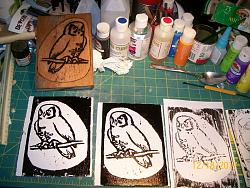Long before the invention of linoleum block printing, and using lead plates to make prints; wood cut block printing was the way in which duplicate prints of hand bills or artwork could be made. The best and most clear of wood cut block prints were made from dense hardwoods with tight, even grains. Pear wood seemed to be the most favored of wood species for this purpose, but others can be (and were) used.
In the video, I show you (and explain) the process of making an “olde tyme” wood cut block print, such that you can try making one yourself. I didn’t have pear wood, so I used a piece of what I think might be maple (salvaged from an old piece of furniture someone threw out). I chose an image of an owl perched on a branch as my subject to use as an example.
The process is simple: Draw or trace an image onto the wood, and then carve/pare away the wood you don’t want to show on your paper, and leave the wood you do want to be shown in the print.
Use of different wood species with large grain will show on your print, but this may be a desired effect in some circumstances.
Here's the video:



 LinkBack URL
LinkBack URL About LinkBacks
About LinkBacks



 Reply With Quote
Reply With Quote

Bookmarks